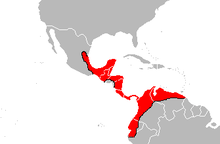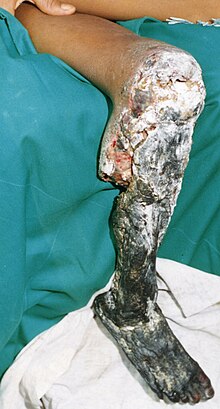Bothrops asper
| Bothrops asper | |
|---|---|
| File:Bothrops-asper.jpg | |
| Scientific classification | |
| Kingdom: | |
| Phylum: | |
| Subphylum: | |
| Class: | |
| Order: | |
| Suborder: | |
| Family: | |
| Subfamily: | |
| Genus: | |
| Species: | B. asper
|
| Binomial name | |
| Bothrops asper (Garman, 1884)
| |

| |
| Geographical range of Bothrops asper. | |
| Synonyms | |
| |
Bothrops asper is a venomous pit viper species found in Central and northern South America.[1] Sometimes referred to as the "ultimate pit viper," these snakes are found in a wide range of lowland habitats, often near human habitations. Large and nervous, this species is the main cause of snakebite incidents within its range.[2] No subspecies are currently recognized.[3]
Description
These are among the most sexually dimorphic of all snakes. The two sexes are born the same size, but at the age of 7 to 12 months, females begin to grow faster than males. Males never reach more than 1.95 m long, while females average perhaps 1.85 m, and the greatest confirmed length is 2.5 m. Females have thick bodies, and big females may weigh 6 kg; heavier ones have been reported. Thus, the females of this species are among the heaviest of all venomous snakes. They also have heads two or three times as big as males in proportion to their size and proportionally bigger fangs (typically 2.5 cm) as well.[4]
The color pattern resembles that of B. atrox: diagonal stripes and diamonds of various shades of brown. The underside of the head is pale yellowish. Newborn snakes are brighter in color and males have yellow tail tips.
Common names
Some of the common names applied to this snake are: terciopelo, fer-de-lance,[2] barba amarilla (Guatemala; "yellow beard"), nauyaca (México; from Nahuatl nahui, four, and yacatl, nose; "four noses"),[5] and yellow-jaw tommygoff (Belize).
The name fer-de-lance is commonly used in North America to refer to this species, as well as to B. atrox, although this name is not used in countries inhabited by this species.[2] The name terciopelo means velvet in Spanish.[6]
Geographic range
Found in the Atlantic lowlands of eastern Mexico and Central America, including Guatemala, Belize, Honduras, Nicaragua, Costa Rica and Panama. A disjunct population occurs in southeastern Chiapas (Mexico) and southwestern Guatemala. In northern South America it is found in Colombia, Ecuador and Venezuela. The type locality given is "Obispo, on the Isthmus of Darien" (Panama).[1]
This is mostly a lowland species that, in Mexico and Central America, occurs from about sea level to 1,200-1,300 m altitude. In South America it apparently ranges to considerably higher elevations: up to 2,500 m in Venezuela and at least 2,640 m in Colombia.(Lancini, 1979).[2]
According to Campbell and Lamar (2004), its range in Ecuador extends as far south along the Pacific coast as El Oro Province and the Vilcabamba area of the Río Catamayo Valley (Freire-Lascano and Kuch, 1994; Schätti and Kramer, 1993). There are even a few records from northern coastal Peru, with these snakes being reported in the Tumbes Region by Tello-V. (1998) Pesantes-Segura (2000). It is also known from the island of Gorgona off the Pacific coast of Colombia.[2]
B. asper occurs throughout the inter-Andes valleys of Colombia across the Caribbean coastal plain through central Venezuela north of the Orinoco as far east as the Delta Amacuro region. This is the only Bothrops species that occurs on the island of Trinidad, although the situation there is complicated due to proximity of Trinidad to the Orinoco Delta where it may be sympatric with B. atrox.[2]
Habitat
It chiefly inhabits tropical rainforest and evergreen forest, but it also occurs in drier areas of tropical deciduous forest, thorn forest and pine savannah near lakes, rivers and streams.
Behavior
This species is mostly nocturnal, hiding in leaf litter or among roots during the day,[4] and are found in a range of different habitats. Juveniles are often semiarboreal and even adults are sometimes encountered in bushes and low trees.[2]
Compared to the common lancehead, B. atrox, these snakes have been described as excitable and unpredictable when disturbed. They can, and often will, move very quickly,[2] usually opting to flee from danger,[4] but are capable of suddenly reversing direction to vigorously defend themselves. Adult specimens, when cornered and fully alert, should be considered quite dangerous. In a review of bites from this species suffered by field biologists, Hardy (1994) referred to it as the "ultimate pitviper."[2]
Reproduction
Males generally stop eating for a time after the beginning of the reproductive cycle, while females stop after a few months of pregnancy. Mating occurs at different times of year in different areas. Gestation is typically 180 to 240 days, and young are born alive. The average litter is about 30, but litters up to 80 or 100 have been reported. Females need extra food after giving birth. Neonates use their tail tips to lure prey (caudal luring).[4]
Venom

This species is an important cause of snakebite within its range. Together with Crotalus durissus it is the leading cause of snakebite in Yucatán, Mexico. It is considered the most dangerous snake in Costa Rica, responsible for 46% of all bites and 30% of all hospitalized cases; before 1947 the fatality rate was 7%, but this has since declined to almost 0% (Bolaños, 1984). In the Colombian states of Antioquia and Chocó it causes 50-70% of all snakebites with a sequelae rate of 6% and a fatality rate of 5% (Otero et al., 1992). In the state of Lara, Venezuela, it is responsible for 78% of all envenomations and all snakebite fatalities (Dao-L., 1971). One of the reasons so many people are bitten is because of its association with human habitation and many bites actually occur indoors (Sasa & Vázquez, 2003). Well-known herpetologist Douglas March died after being bitten by this species.[8]
This species is irritable, fast-moving and agile. It is also regarded as being more excitable and unpredictable than B. atrox, and has a reputation for being aggressive. Its large size and habit of raising its head high off the ground can result in bites above the knee. It has also been observed to eject venom over a distance of at least 6 feet (1.8 m) in fine jets from the tips of its fangs (Mole, 1924).[8]
Bite symptoms include pain, oozing from the puncture wounds, local swelling that may increase for up to 36 hours, bruising that spreads from the bite site, blisters, numbness, mild fever, headache, bleeding from the nose and gums, hemoptysis, gastrointestinal bleeding, hematuria, hypotension, nausea, vomiting, impaired consciousness and tenderness of the spleen. In untreated cases, local necrosis frequently occurs and may require amputation. In 12 fatal cases the cause of death was septicemia (5), intracranial hemorrhage (3), acute renal failure with hyperkalemia and metabolic acidosis (2) and hemorrhagic shock (1).[8]
Venom yield (dry weight) averages 458 mg with a maximum of 1530 mg (Bolaños, 1984)[8] and an LD50 in mice of 2.844 mg/kg IP.[4]
It has been suggested that the venomous bite of B. asper was a factor in the choice of certain Mayan settlements such as Nim Li Punit, where the thick jungle inhabited by these snakes was used as a defensive boundary.[9]
Taxonomy
This species was formerly regarded as a subspecies of B. atrox and is still often confused with it.[4]
See also
- List of crotaline species and subspecies
- Bothrops by common name
- Bothrops by taxonomic synonyms
- Crotalinae by common name
- Crotalinae by taxonomic synonyms
- Snakebite
References
- ^ a b c McDiarmid RW, Campbell JA, Touré T. 1999. Snake Species of the World: A Taxonomic and Geographic Reference, vol. 1. Herpetologists' League. 511 pp. ISBN 1-893777-00-6 (series). ISBN 1-893777-01-4 (volume).
- ^ a b c d e f g h i j Campbell JA, Lamar WW. 2004. The Venomous Reptiles of the Western Hemisphere. Comstock Publishing Associates, Ithaca and London. 870 pp. 1500 plates. ISBN 0-8014-4141-2.
- ^ "Bothrops asper". Integrated Taxonomic Information System. 6 November.
{{cite web}}: Check date values in:|date=and|year=/|date=mismatch (help) - ^ a b c d e f Captive care of B. asper at VenomousReptiles.org. Accessed 6 November 2006.
- ^ Diccionario de la Real Academia Española, 22a. ed. Consulted March 27, 2009
- ^ Clothes at Online resources for Spanish language learning. Accessed 3 February 2007.
- ^ Norris R. 2004. Venom Poisoning in North American Reptiles. In Campbell JA, Lamar WW. 2004. The Venomous Reptiles of the Western Hemisphere. Comstock Publishing Associates, Ithaca and London. 870 pp. 1500 plates. ISBN 0-8014-4141-2.
- ^ a b c d Warrell DA. 2004. Snakebites in Central and South America: Epidemiology, Clinical Features, and Clinical Management. In Campbell JA, Lamar WW. 2004. The Venomous Reptiles of the Western Hemisphere. Comstock Publishing Associates, Ithaca and London. 870 pp. 1500 plates. ISBN 0-8014-4141-2.
- ^ Nim Li Punit by C. Michael Hogan, at Megalithic Portal. Accessed 15 March 2008.
Further reading
- Bolaños R. 1984. Serpientes, venenos, y ofidismo en Centroamérica. Editoria Universidad de Costa Rica, San José. 136 pp.
- Dao-L. L. 1971. Emponzoñamiento ofícido en el Estado Lara. Gaceta Medica de Caracas 79: 383-410.
- Otero R, Tobón GS, Fernando Gómez L, Osorio R, Valderrama R, Hoyos D, Urreta JE, Molina S, Arboleda JJ. 1992. Accidente ofídico en Antioquia y Chocó. Aspectos clínicos y epidimiológicos (marzo de 1989-febrero de 1990). Acta Médica Colombiana 17: 229-249.
- Sasa M, Vázquez S. 2003. Snakebite envenomation in Costa Rica: a revision of incidence in the decade 1990-2000. Toxicon 41(1): 19-22.
External links
- Bothrops asper at the Reptarium.cz Reptile Database. Accessed 6 December 2007.
